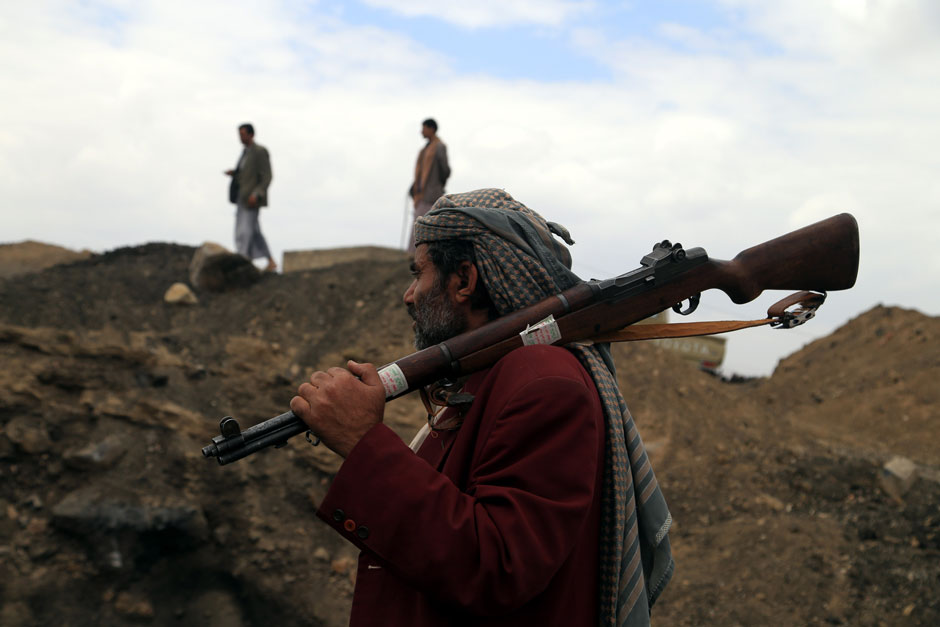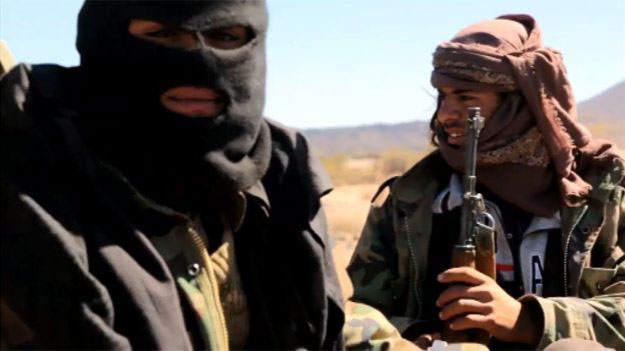There is a scene in Safa al Ahmad’s remarkable BBC documentary, Yemen: The Rise of the Houthis, when a spokesman for the Houthi movement escorts her to a remote and unguarded section of the border between Yemen and Saudi Arabia. It is nothing more than a half-trampled barbed-wire fence, in a golden-brown landscape of dry hills and scattered acacia trees. “This means nothing, it represents nothing,” he says of the border. The Houthis, a once-obscure band of insurgents from the mountains of northern Yemen who adhere to the Zaydi branch of Shia Islam, have over the past few months taken over much of the country. “We cannot be defined by sect or confined by borders,” the spokesman says. “We will help oppressed people all over the world.” Then, flourishing a confident smile, he predicts the imminent demise of the House of Saud.
That moment of hubris, filmed late last year, acquired a sinister new meaning last week when Saudi Arabia launched a campaign of airstrikes on Yemen. The Saudis said their strikes—carried out with eight allied Arab and Muslim states—were meant to push back the Houthis. But the Saudis clearly intended their blitzkrieg as a blunt message to Iran, their great nemesis and rival, which has provoked the Saudis for several years now by providing money and weaponry to the Houthis.
Yemen, in other words, has become the latest proxy battleground in the sectarian struggle now playing out across the Middle East. It did not have to be this way. The Houthis, unlike Hezbollah and other Shiite movements, do not take directions from Tehran, and have received relatively small amounts of aid. (In the film, Houthi officials flatly deny any Iranian support, claiming they were equally close to Venezuelan leader Hugo Chávez.) Their Zaydi faith is doctrinally closer to Sunnism than to the Shiite Islam practiced in Iran. But the rulers of Saudi Arabia and other Sunni states are feeling a profound defensiveness about Iranian power, which is on display every day in the wars in Syria and Iraq. They want to lay down a marker.
This chest-beating gesture could backfire catastrophically, even if it succeeds in weakening the Houthis. The Saudi airstrikes quickly destroyed most of Yemen’s military arsenal, including hundreds of millions of dollars’ worth of American equipment. It will be all the more difficult now for any one faction to control the country. Militias of all kinds are sure to proliferate, and al-Qaeda in the Arabian Peninsula, which is based in Yemen and which has tried several times to detonate bombs on US-bound commercial airliners, will have more room to maneuver. All this could have terrifying consequences for ordinary people: Yemen is the Arab world’s poorest country, and is rapidly running out of water. Getting food and water to 25 million people who are surrounded by a crazy-quilt of battling militias and jihadis could be almost impossible.
Al Ahmad’s film is a rare close-up look at the most mysterious player in this agonizing and complex drama. The Houthi movement has long been an enigma, even to many Yemenis, and it defies easy explanation. This is partly because the Houthis are secretive and protective of their leaders, and partly because their goals have shifted over time. When I first started reporting on them, almost a decade ago, they were an obscure group confined to Yemen’s far northwest, and the Yemeni military was bombarding them for reasons few Yemenis seemed to understand. Their movement grew out of a deep sense of victimization by the state, and al Ahmad captures this with unusual footage from Saada, the Houthi heartland, including scenes of the cave (now a kind of shrine) where the group’s founder, Hussein al Houthi, made his last stand before being killed in 2004.
Yemen’s population is about a third Zaydi (the rest are Sunnis), and the country was ruled—on and off—for a thousand years by an elite caste of Zaydis who traced their ancestry to the prophet Muhammad. After the republican revolution in 1962, the state mistreated many of these Zaydis, seeing them as a potential fifth column. In the 1980s, the government started subsidized the building of Saudi-style Sunni schools and mosques right in the Zaydi heartland, provoking the Zaydis to fight back with their own revivalist religious ideology. The more militant Zaydis increasingly saw Saudi Arabia, with its intolerant view of all Shiites, as their enemy; and they took inspiration from the Iranian revolution of 1979, including its opposition to Western interference in the Middle East (they are known for chanting a slogan that includes the words “Death to America” at mosques and rallies). Hussein al Houthi declared his resistance to Yemeni policies in 2003, and the state quickly took up arms against him and his followers.
Advertisement
After Hussein’s death in 2004, Yemen’s US-backed president, Ali Abdullah Saleh, continued waging intermittent wars on the Houthis—now led by his brother, Abdulmalik. These were carried out with such brutality and incompetence that the Houthi movement grew in size and fighting ability, gaining sympathy from northern tribes who suffered in the wars. After the uprising in 2011 that ultimately forced Saleh to step aside, Yemen was theoretically governed by Abd Rabbuh Mansour Hadi, the new president named in a transitional process underwritten by the Gulf states and the US. In reality, the government was losing control of the country, with al-Qaeda bombers and kidnappers running rampant. The Houthis were the only group with the cohesion and discipline to hold terrain. They grew even stronger after forming a tactical alliance with their former enemy, ex-president Saleh, who still controlled much of the military. And the Iranians gave them the money they needed for the final push to Sanaa, the capital, last fall.
Al Ahmad (who is a friend I’ve worked with occasionally) began making her film in Sanaa two weeks after the Houthis had taken over. They were keen to present themselves as spokesmen for the unfulfilled democratic revolution of 2011, and they gave her extensive access. In one scene, she arrives at the finance ministry following a Houthi leader and his brazen entourage, who barge into the deputy minister’s office with no appointment. When the minister tells him to follow protocol and book a meeting, the Houthi representative—dressed in a suit and tie—slaps his hand on the desk and shouts: “The people are monitoring you and they demand transparency! The days of dictatorship are over and you can’t tell us what to do.” The minister, seemingly unfazed by the conquerers standing over him, says: “The people want to monitor you.” The Houthi man, stunned and outraged, replies: “This old language no longer works, we crushed it with our shoes! People don’t realize the new reality we are in.” He storms out, after forcing the minister to sign a document (meaningless, of course) authorizing an investigation of misspent funds. This is revolutionary slapstick worthy of Charlie Chaplin, and to have captured it on camera is a real achievement.
One of the ironies of the Saudi bombardment is that the Houthis are fierce enemies of al-Qaeda’s Yemeni branch, which has long posed a threat to the Saudi regime, including launching attacks in Saudi Arabia itself. And the Houthis are far more effective at fighting al-Qaeda than the Yemeni government ever was. (In her film, al Ahmad visits a former al-Qaeda hotbed south of Sanaa where the Houthis had managed to restore order for the first time in years.) But the United States is supporting the Saudi campaign, thereby shredding the chances of an American entente with the Houthis.
Admittedly, such cooperation would never have been easy, not just because of the Saudi objections and the links with Iran, but because anti-Americanism is part of the Houthi project. Al Ahmad also makes clear that Houthi self-righteousness helped provoke the current war. Their domineering behavior in the capital—replacing Sunni imams with their own people, and settling scores with perceived enemies—alienated many potential supporters and polarized the country. Still the Houthis can be flexible and pragmatic, as their alliance with Saleh shows. It is hard to believe that some sort of deal could not have been struck between the Houthis and the Saudis, whose financial involvement in Yemen gives them great leverage. The US would have every interest in promoting such an agreement. As one Yemeni said to me: “One group of Houthi fighters is worth a hundred drones.”
Houthi fighters have been fighting al-Qaeda and various Sunni Islamist groups for years now. Al Ahmad’s film includes footage, taken at great risk, of one of the front lines in these battles, in Bayda province in southern Yemen. Her interviews document a major mobilization of Sunnis who feel—like their co-religionists in Saudi Arabia—deeply threatened by what they now see as a “Shiite” onslaught. One of the Sunni militiamen she speaks to says: “Even if al-Qaeda and I have disagreements, if we are fighting in the same trench against the Houthis, he is my brother.”
This could be the beginning of a civil war that will deepen no matter how many bombs the Saudis drop. It is also likely to make Yemen a greater threat to the rest of the world. But the real tragedy is that all this is happening in a country where shared traditions were always the rule, laughter and qat-chewing were in every house, and sectarian differences meant almost nothing until recent years.
Advertisement
Safa al Ahmad’s film Yemen: The Rise of the Houthis will be shown on PBS’s Frontline on April 7, and will be available for streaming on the PBS website beginning April 7 at 10 PM eastern time.




